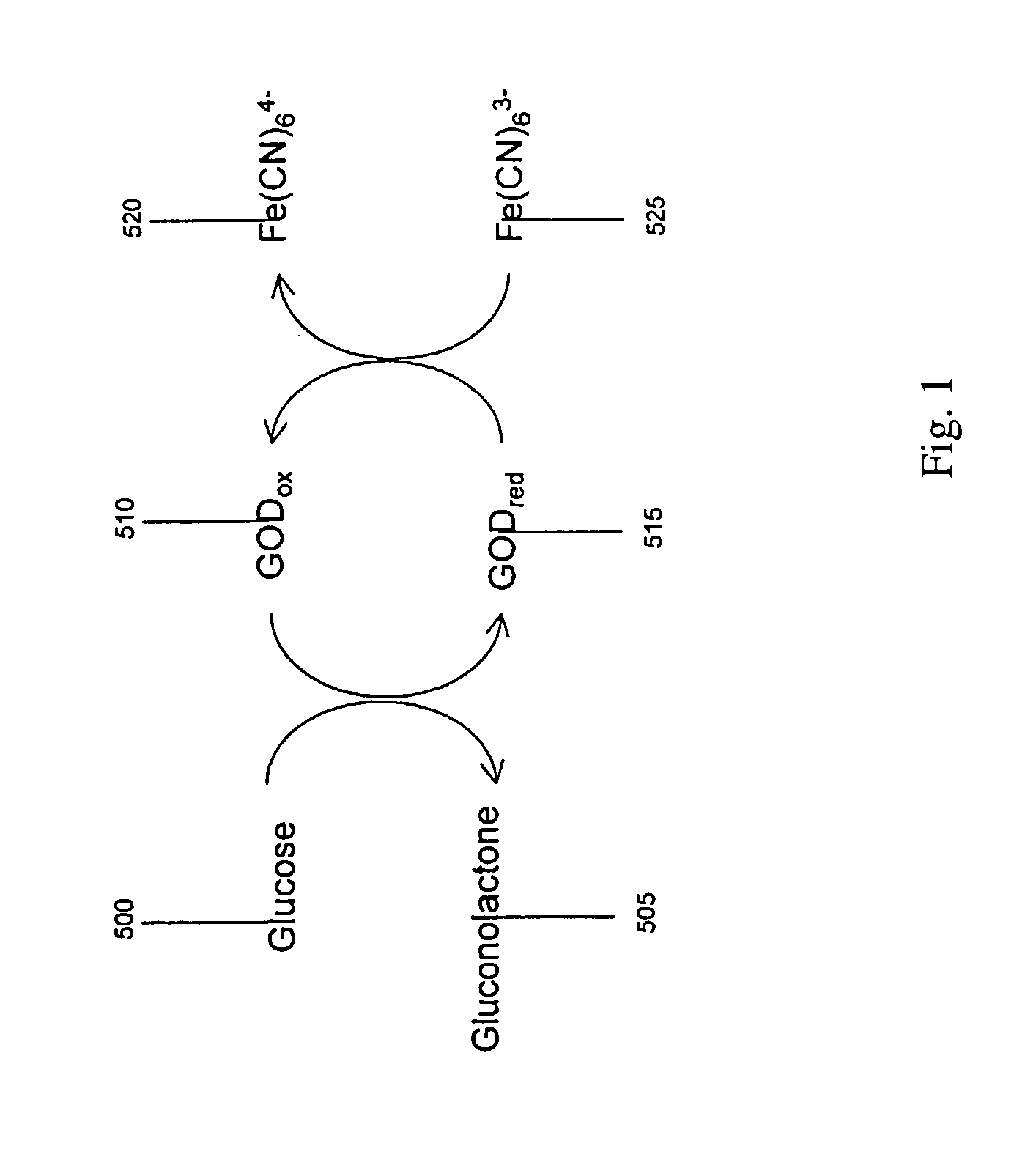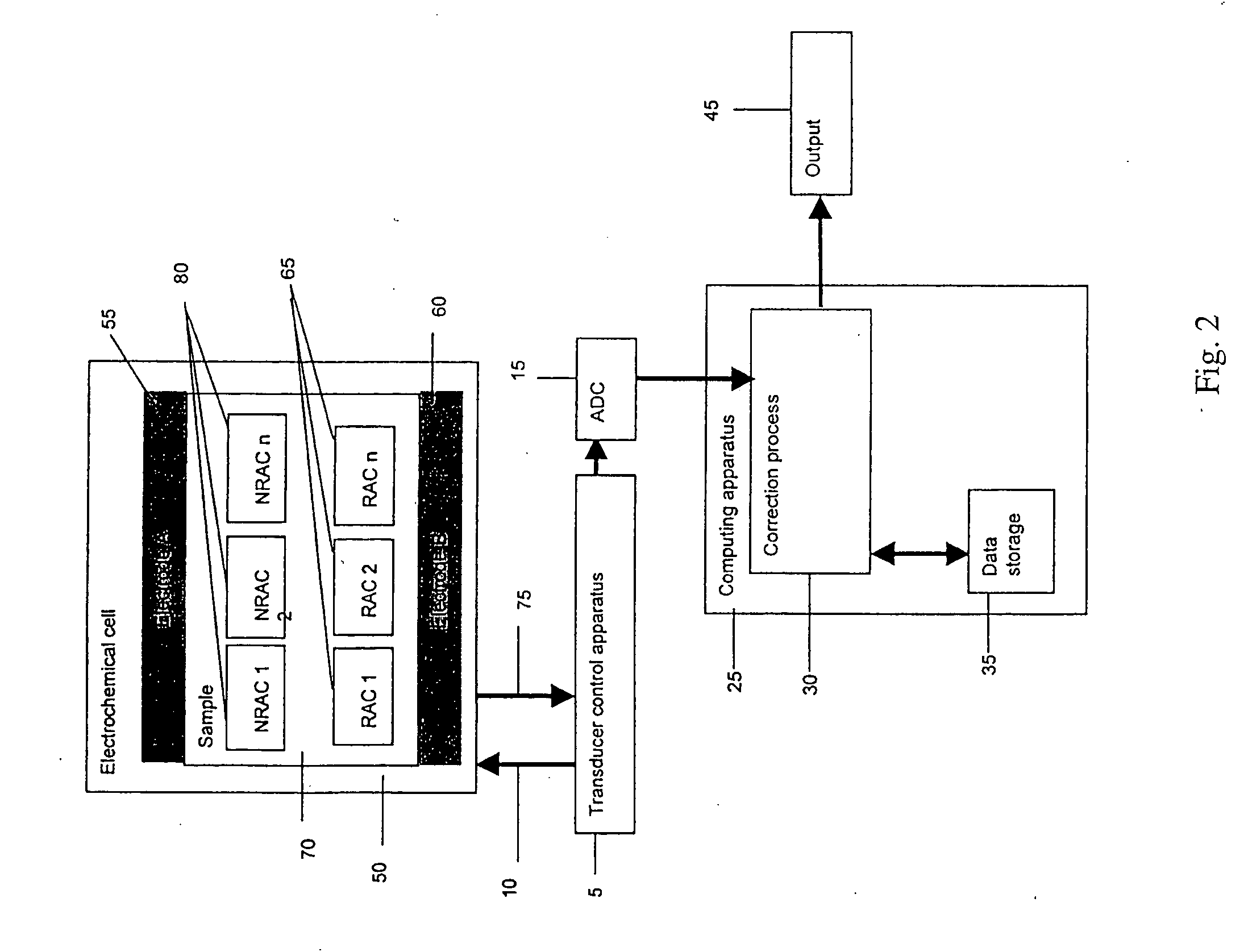Method and apparatus for assay of electrochemical properties
a technology of electrochemical properties and methods, applied in the direction of materials, electrochemical variables, applications, etc., can solve the problems of increasing the cost of disposable devices, affecting the accuracy of measurement, and the small amount of current passed is reaching the natural limit of amperometric sensors, so as to improve the accuracy and precision of measurement, improve the accuracy of measurement, and improve the effect of measurement accuracy
- Summary
- Abstract
- Description
- Claims
- Application Information
AI Technical Summary
Benefits of technology
Problems solved by technology
Method used
Image
Examples
example 1
[0139] Correcting for variations in PT: One example of using PT to increase the accuracy of electrochemical sensor measurements is discussed. FIG. 9 shows one example relationship than can exist between PT and the measured current for different analyte concentrations. The data in FIG. 9 was simulated according to a conduction-cell electrochemical sensor as illustrated by the example drawings in FIG. 3 and FIGS. 7A-C. FIG. 9 illustrates the variation in current (given in amps) for different values of PT for a sensor comprised of each electrode having an effective surface area of 1 cm2. Data points are shown in FIG. 9 for the steady-state current that is generated by the application of a voltage difference of 0.4 V between the two electrodes for a sample comprised of 2 mM ferrocyanide 1400 and 1 mM ferrocyanide 1405. It is clear that the measured current is dependent upon both the concentration of analyte and the value of PT. Thus, variations in the value of PT can cause signal variat...
example 2
[0163] In another example embodiment, the conduction-cell electrochemical sensor is operated as a biosensor. In this case, a set of chemical reactions produces an analyte to be detected by the conduction-cell electrochemical sensor. One embodiment of this is illustrated in FIG. 1 where an enzyme glucose oxidase catalyzes a reaction with glucose. In this example, glucose 500 reacts with the oxidized form of glucose oxidase, GODox 510, thereby converting the enzyme to its reduced form GODred 515 and producing gluconolactone 505. GODred 515 can react with ferricyanide, Fe(CN)63- 525 to be returned to its oxidized state GODox 510 and produce ferrocyanide, Fe(CN)64- 520. Thus, the concentration of glucose may be estimated by determining the concentration of ferrocyanide by the method and apparatus of embodiments of the invention.
[0164] The measured current can be related to the glucose concentration by a calibration curve equation. One example of such an equatio...
example 3
Example Embodiments of Transducer Control Apparatus
[0165] One example embodiment of the transducer control apparatus 5 in FIG. 2 is discussed. FIG. 15 illustrates a schematic for one example embodiment of the Transducer control apparatus 5. Two electrodes 2100 and 2105 are coupled to the TCS 5 by substantially conductive paths 2110 and 2115. A stimulus application unit 2150 can apply a potential difference between substantially conductive paths 2110 and 2130. The stimulus application unit 2150 can vary the potential difference in time. A current quantification unit 2120 monitors the current that flows along lead 2110. One of ordinary skill in the art will recognize that the current flowing along lead 2110 is substantially the same as the current flowing along leads 2115 and 2130. The current quantification unit 2120 may be connected to lead 2115 or 2130 instead of to lead 2110. This embodiment does not limit the invention. A switch unit 2135 allows the ability to electrically conne...
PUM
 Login to View More
Login to View More Abstract
Description
Claims
Application Information
 Login to View More
Login to View More - R&D
- Intellectual Property
- Life Sciences
- Materials
- Tech Scout
- Unparalleled Data Quality
- Higher Quality Content
- 60% Fewer Hallucinations
Browse by: Latest US Patents, China's latest patents, Technical Efficacy Thesaurus, Application Domain, Technology Topic, Popular Technical Reports.
© 2025 PatSnap. All rights reserved.Legal|Privacy policy|Modern Slavery Act Transparency Statement|Sitemap|About US| Contact US: help@patsnap.com



